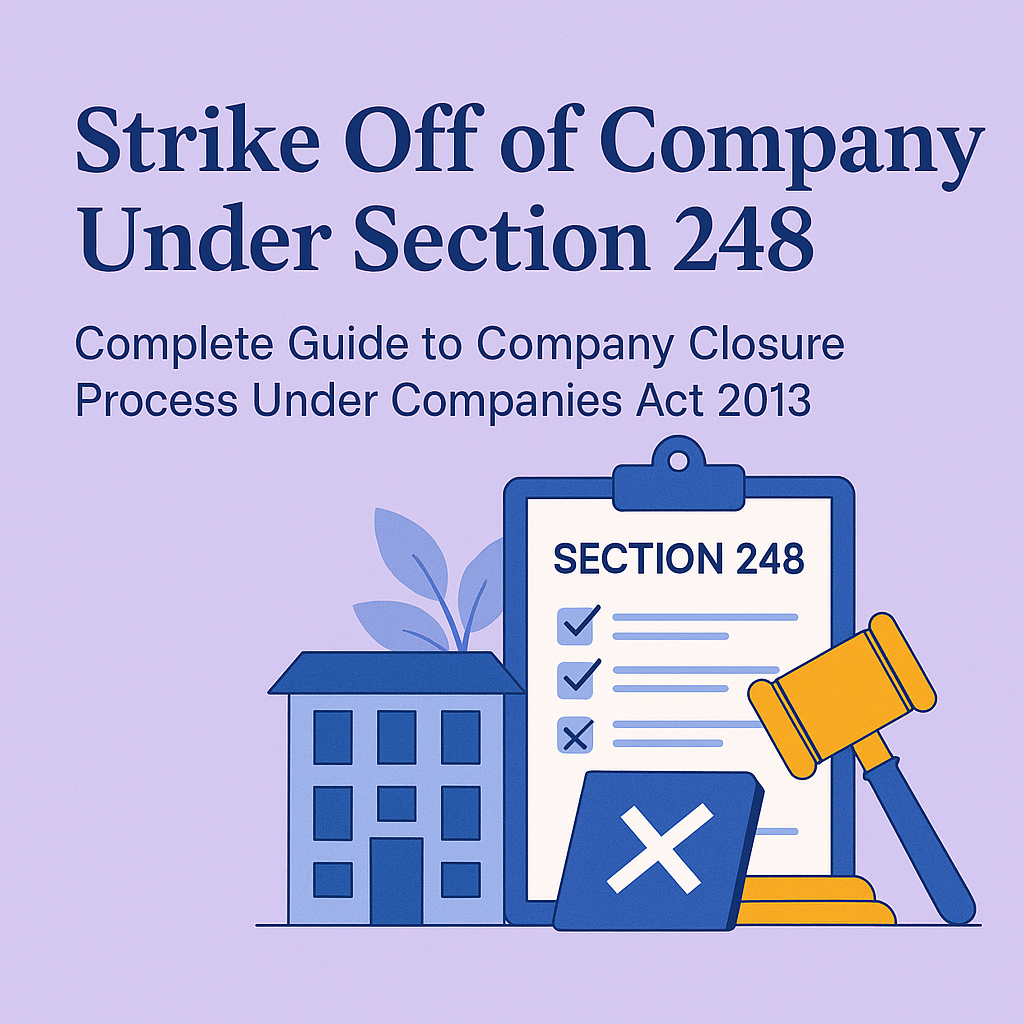Strike Off of Company Under Section 248
Complete Guide to Company Closure Process Under Companies Act 2013
Table of Contents
Introduction
When a company ceases operations and wants to close down legally, strike off under Section 248 of the Companies Act 2013 provides a simplified route for closure. This process is particularly suitable for dormant companies or those with minimal assets and liabilities.
Understanding the strike off process is crucial for company directors, compliance officers, and business owners looking to wind up their companies efficiently while ensuring full regulatory compliance.
Understanding Strike Off Under Section 248
What is Strike Off?
Strike off is a process where a company’s name is removed from the Register of Companies (ROC) maintained by the Ministry of Corporate Affairs (MCA). Once struck off, the company ceases to exist as a legal entity.
Key Features:
- Voluntary Process: Initiated by the company itself
- Cost-Effective: Less expensive than formal winding up procedures
- Simplified: Streamlined process compared to liquidation
- Final: Company ceases to exist upon strike off
Legal Framework:
- Primary Legislation: Section 248 of the Companies Act 2013
- Rules: Companies (Removal of Names of Companies from Register of Companies) Rules 2016
- Forms: STK-2 (Application for Strike Off)
Conditions for Strike Off
Mandatory Conditions (All Must Be Met):
1. No Business Operations
- Company has not carried on any business or operations for immediately preceding two financial years
- No significant accounting transactions recorded
2. Asset and Liability Position
- No assets and liabilities OR
- Assets do not exceed ₹1 lakh and liabilities do not exceed ₹1 lakh
3. Compliance Status
- Company is not in default in filing annual returns or financial statements
- All statutory compliances are up to date
4. Legal Clearances
- No pending proceedings before any court, tribunal, or statutory authority
- No investigation pending under Companies Act 2013
5. Secured Creditors
- Company has no secured creditors
- All debts (if any) are settled
6. Public Deposits
- Company has not accepted any deposits from public
- No deposit liability exists
Documents Required for Strike Off
1. Board Resolution
- Resolution approving strike off application
- Signed by all directors
- Clearly stating reasons for strike off
2. Shareholders’ Resolution
- Special resolution passed by shareholders
- 75% majority required for approval
- Consent for strike off application
3. Financial Documents
- Latest audited financial statements
- Statement of assets and liabilities
- Bank statements for last two years
4. Compliance Documents
- Certificate from Company Secretary/Chartered Accountant
- Confirmation of no pending compliances
- ROC filing status certificate
5. Legal Documents
- Indemnity bond by directors
- Affidavit confirming no pending legal proceedings
- NOC from secured creditors (if applicable)
6. Tax Clearances
- Income Tax clearance certificate
- GST clearance certificate
- Professional tax clearance (if applicable)
7. Regulatory Clearances
- NOC from respective regulatory bodies
- Sector-specific clearances (if required)
- Environmental clearance (if applicable)
Step-by-Step Process
1Pre-Application Preparation
Compliance Check
- Verify all statutory filings are up to date
- Clear any pending defaults
- Obtain necessary clearances
Documentation
- Gather all required documents
- Prepare board and shareholders’ resolutions
- Obtain professional certificates
2Filing Application
Form STK-2 Filing
- File application with ROC online via MCA portal
- Attach all supporting documents
- Pay prescribed fees
Publication Requirement
- Publish notice in newspaper (English and regional language)
- Display notice on company’s website
- Inform stakeholders about strike off intention
3Objection Period
30-Day Window
- Creditors/stakeholders can raise objections
- ROC reviews all objections received
- Company may need to respond to objections
ROC Examination
- Verification of submitted documents
- Compliance status check
- Investigation if required
4Final Orders
Approval/Rejection
- ROC issues final order
- Company name struck off from register
- Dissolution certificate issued
Gazette Notification
- Strike off published in Official Gazette
- Company ceases to exist legally
- Assets vest in Central Government
Timeline and Fees
| Processing Stage | Timeline | Details |
|---|---|---|
| Application Filing | 1-2 days | Online submission via MCA portal |
| Publication Period | 30 days | Newspaper publication and objection period |
| ROC Processing | 60-90 days | Document verification and approval |
| Total Timeline | 3-4 months | Approximate total processing time |
Fee Structure:
- Application Fee: ₹10,000
- Publication Cost: ₹3,000-5,000
- Professional Fees: ₹10,000-25,000
- Total Estimated Cost: ₹18,000-35,000
Government Fees:
- STK-2 filing fee: ₹10,000
- Additional fees for delayed filings (if applicable)
Important Considerations
Legal Implications:
- Irreversible Process: Once struck off, company cannot be revived easily
- Asset Transfer: All assets vest in Central Government
- Director Liability: Directors remain liable for past acts
- Restoration: Possible within 20 years through NCLT
Tax Implications:
- Final Tax Returns: Must be filed before strike off
- Tax Clearances: Mandatory from all tax authorities
- Deemed Distribution: May attract tax implications
Regulatory Compliance:
- Sectoral Clearances: Required from respective regulators
- Environmental Compliance: Clearance from pollution control boards
- Labour Law Compliance: Settlement of all employee dues
Practical Tips:
- Maintain Records: Keep all documents for future reference
- Professional Assistance: Engage qualified professionals
- Timeline Management: Start process well in advance
- Stakeholder Communication: Keep all stakeholders informed
Useful Links
For detailed information and forms, visit:
Conclusion
Strike off under Section 248 provides an efficient mechanism for company closure, particularly suitable for dormant companies. However, it requires careful planning, complete documentation, and full compliance with regulatory requirements.
The process, while streamlined, demands attention to detail and professional expertise to ensure smooth execution. Companies considering strike off should evaluate their eligibility carefully and engage qualified professionals to navigate the process successfully.
Remember that strike off is a permanent decision with significant legal and financial implications. Therefore, it’s essential to consider all alternatives and ensure complete compliance before initiating the process.
Read more about MCA V3
